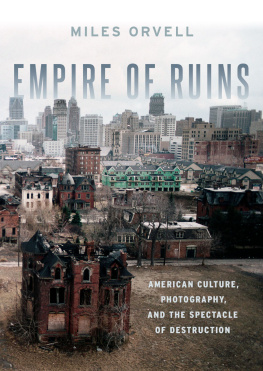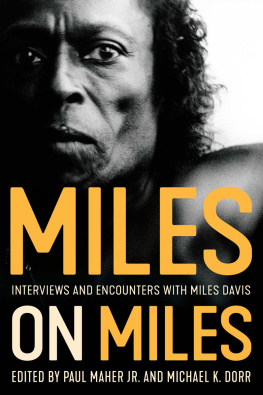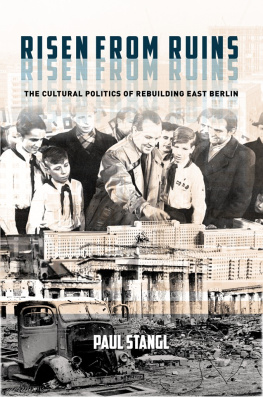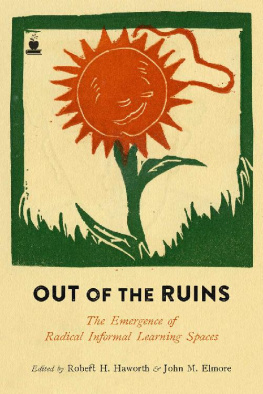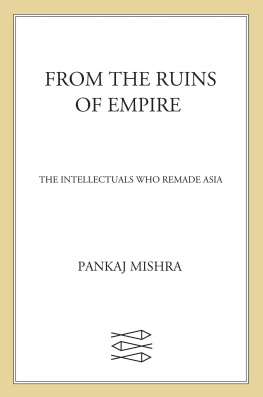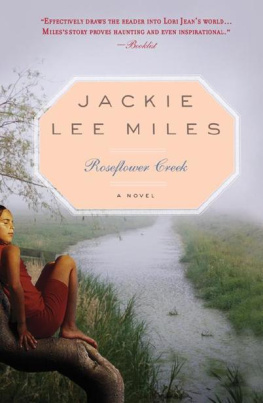Miles Orvell - Empire of Ruins
Here you can read online Miles Orvell - Empire of Ruins full text of the book (entire story) in english for free. Download pdf and epub, get meaning, cover and reviews about this ebook. year: 2020, publisher: Oxford University Press, genre: Romance novel. Description of the work, (preface) as well as reviews are available. Best literature library LitArk.com created for fans of good reading and offers a wide selection of genres:
Romance novel
Science fiction
Adventure
Detective
Science
History
Home and family
Prose
Art
Politics
Computer
Non-fiction
Religion
Business
Children
Humor
Choose a favorite category and find really read worthwhile books. Enjoy immersion in the world of imagination, feel the emotions of the characters or learn something new for yourself, make an fascinating discovery.
- Book:Empire of Ruins
- Author:
- Publisher:Oxford University Press
- Genre:
- Year:2020
- Rating:4 / 5
- Favourites:Add to favourites
- Your mark:
- 80
- 1
- 2
- 3
- 4
- 5
Empire of Ruins: summary, description and annotation
We offer to read an annotation, description, summary or preface (depends on what the author of the book "Empire of Ruins" wrote himself). If you haven't found the necessary information about the book — write in the comments, we will try to find it.
Empire of Ruins — read online for free the complete book (whole text) full work
Below is the text of the book, divided by pages. System saving the place of the last page read, allows you to conveniently read the book "Empire of Ruins" online for free, without having to search again every time where you left off. Put a bookmark, and you can go to the page where you finished reading at any time.
Font size:
Interval:
Bookmark:


Oxford University Press is a department of the University of Oxford. It furthers
the Universitys objective of excellence in research, scholarship, and education by publishing worldwide. Oxford is a registered trade mark of Oxford University Press in the UK and certain other countries.
Published in the United States of America by Oxford University Press
198 Madison Avenue, New York, NY 10016, United States of America.
Miles Orvell 2021
All rights reserved. No part of this publication may be reproduced, stored in a retrieval system, or transmitted, in any form or by any means, without the prior permission in writing of Oxford University Press, or as expressly permitted by law, by license, or under terms agreed with the appropriate reproduction rights organization. Inquiries concerning reproduction outside the scope of the above should be sent to the Rights Department, Oxford University Press, at the address above.
You must not circulate this work in any other form and you must impose this same condition on any acquirer.
Library of Congress Cataloging-in-Publication Data
Names: Orvell, Miles, author.
Title: Empire of ruins : American culture, photography, and the spectacle
of destruction / Miles Orvell.
Description: New York : Oxford University Press, [2021] |
Includes bibliographical references and index. |
Identifiers: LCCN 2020029608 (print) | LCCN 2020029609 (ebook) |
ISBN 9780190491604 (hardback) | ISBN 9780190491628 (epub) |
ISBN 9780190491611 (pdf) | ISBN 9780197523285
Subjects: LCSH: Ruins in art. | Ruined buildingsPictorial works. |
Ruined buildingsSocial aspectsUnited States. | Arts and societyUnited States.
Classification: LCC NX650.R84 O78 2021 (print) | LCC NX650.R84 (ebook) | DDC 720dc23
LC record available at https://lccn.loc.gov/2020029608
LC ebook record available at https://lccn.loc.gov/2020029609
DOI: 10.1093/oso/9780190491604.001.0001
Dedicated to the power of trees to break apart stone and to our human capacity to rebuild ruined cities and heal the scarred earth; dedicated to my children, to their children after them, and to all children whose world this is
Looking Back on Tomorrow: |
Empire of Ruins began on September 11, 2001 and the days afterwards, as I watched the spectacle of destruction flooding mass media. Like millions of others, I was riveted by television images and photographs one could not have imagined ever seeing. Reflecting on these pictures, baffled by them, I eventually felt that I must write about them, and in the succeeding years, after writing about 9/11, I found myself considering an even broader range of ruinscities, landscapes, scenes of war and wastewondering what patterns, if any, lay beneath the broken stones and how they connected with American culture. Like many people in the twenty-first century, I became obsessed with ruins.

Any book on ruins is, in a sense, about everything and about nothing: everything, because, sooner or later, all things will end in ruins; and nothing, because ruins reveal what is no longer there and has vanished from sight, or lies in rubble. Empire of Ruins is also, more precisely, a book about how we look at ruins, and I assume a double vision in doing so, since any picture of a ruin is not only about the thing pictured but about how it is represented and what it is made to represent. And it is part of my argument in this book that photography has been the chief means by which the cultural meaning of ruins has been created.
Ruins have symbolized the passage of time for thousands of years, especially during the Renaissance, when artists began painting ruins with a sense of wonder and delight. But the artists depiction of the ruins of Rome or Athens encouraged the sense that, despite symbolizing mutability, ruins were themselves somehow permanent. Photography changed that, for with the invention of the camera in 1839, it became possible to record things from day to day and to observe times passing with a new consciousness. Secure the shadow, ere the substance fades, was the frank slogan used by early photographers who motivated their customers to commission family photographs by reminding them of mortality. Empire of Ruins assumes an inherent symbiosis between photography and ruins, for since the Civil War, the camera has been the chief means by which Americans saw the force of time and change in the material culture that surrounded their livesand that remains so to the present day. And yet, the way the camera has been used has changed considerably from the 1860s to the present, and so has the meaning of ruin photography.
The trajectory of Empire of Ruins is roughly historical. My purpose is to explain a pattern that has been largely concealed in previous discussions of ruinsthe progression from a nineteenth-century quest for ancient ruins as a sign of cultural prestige to the twentieth centurys acceptance of contemporary ruins as a necessary concomitant of progress, to the twenty-first-century realization that weve created a world of ruin that is all but inescapable. Exploring the range of ruin photography and investigating its attraction as a visual spectacle, Empire of Ruins provides the foundation for understanding our aesthetic fascination with the pictorializaton of ruins at the same time that it posits a necessary moral response to ruin photography. Echoing Yeatss epigraph to a 1914 volume of poetryIn Dreams Begin Responsibilities one might say now, in the twenty-first century, that in ruins begin responsibilities.
If this book is, in part, an accident of history, it is also, for me, the continuation of an inquiry into the symbolism of American material culture that began with The Real Thing: Imitation and Authenticity in American Culture, which explored the dialectic of "originals" and "copies" in American civilization. In The Death and Life of Main Street: Small Towns in American Memory, Space, and Community, I turned from things to places, looking at the conflicted meanings of Main Street in America, from the real to the imagined. Empire of Ruins extends this trajectory, by exploring the destruction of space and the authenticity of ruins. My approach to these subjects has been to see how thingsobjects, urban space, landscapes, buildingsacquire symbolic meaning through visual and literary representation and how these representations in turn shape cultural beliefs and ideologies.
Many debts of gratitude lie behind this book. My thanks first of all to the College of Liberal Arts and Temple University, for awarding me a Study Leave that enabled me to complete this work; and to the Center for the Humanities at Temple and its director, Petra Goedde, for additional support at a crucial time. To Kate Henry, my department chair, my warmest thanks for her constant support in all ways. Possibly the best part about being an academic is the privilege of being able to talk about your obsession, and I offer my gratitude to colleagues for their kind invitations to speak about this subject over the years. Thanks especially to these friends for encouragement and advice, in a multitude of ways, big and small, over the years: Klaus Benesch, David Berg, Matthew Bokovoy, Simon Bronner, Tim Corrigan, Julia Faisst, Marcia Ferguson, Divina Frau Meigs, Ingrid Gessner, Mick Gidley, John Haddad, Udo Hebel, Alfred Hornung, Gerd Hurm, Carolyn Karcher, Susanne Leikam, David Lubin, Laura Madeleine, Maxine Margolis, Mark Meigs, Jeff Meikle, David Nye, Sharon OBrien, Marla Painter, Stephen Perloff, Richard Pressman, Charles Pritchard, Tom Riggio, Asaf Romirowsky, Mark Rudd, Laurence Salzmann, Kerstin Schmidt, Allen Scult, Stuart Shils, Herb Simons, Alan Singer, Alan Soffin, Maren Stange, Judy Tuwaletstiwa, Faith Watson, Byron Wolfe, Shamoon Zamir, and Jeffrey Zeman.
Font size:
Interval:
Bookmark:
Similar books «Empire of Ruins»
Look at similar books to Empire of Ruins. We have selected literature similar in name and meaning in the hope of providing readers with more options to find new, interesting, not yet read works.
Discussion, reviews of the book Empire of Ruins and just readers' own opinions. Leave your comments, write what you think about the work, its meaning or the main characters. Specify what exactly you liked and what you didn't like, and why you think so.

